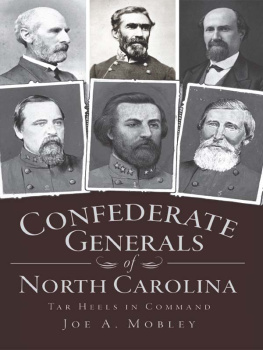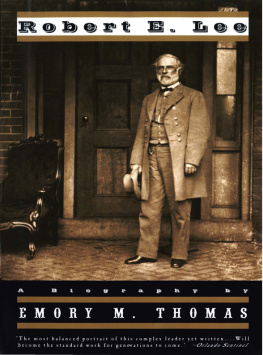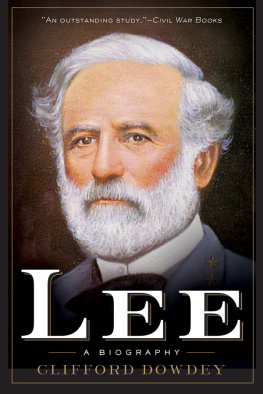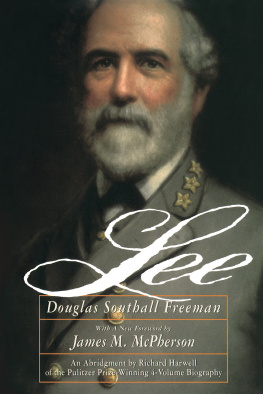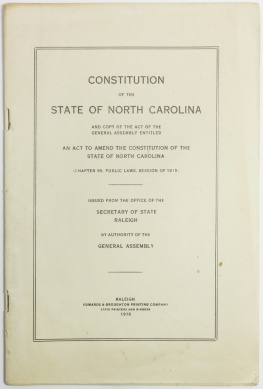

Published by The History Press
Charleston, SC 29403
www.historypress.net
Copyright 2011 by Joe A. Mobley
All rights reserved
All images courtesy of the North Carolina State Archives.
First published 2011
e-book edition 2012
ISBN 978.1.61423.395.4
Mobley, Joe A.
Confederate generals of North Carolina : Tar Heels in command / Joe A. Mobley.
p. cm.
Includes bibliographical references.
print edition ISBN 978-1-60949-048-5
1. Generals--Confederate States of America--Biography. 2. Generals--North Carolina--Biography. 3. Confederate States of America. Army--Officers--Biography. 4. North Carolina--History--Civil War, 1861-1865--Biography. 5. United States--History--Civil War, 1861-1865--Biography. 6. United States--History--Civil War, 1861-1865--Campaigns. 7. North Carolina--Biography. I. Title.
E467.M69 2011
355.00922--dc23
[B]
2011029178
Notice: The information in this book is true and complete to the best of our knowledge. It is offered without guarantee on the part of the author or The History Press. The author and The History Press disclaim all liability in connection with the use of this book.
All rights reserved. No part of this book may be reproduced or transmitted in any form whatsoever without prior written permission from the publisher except in the case of brief quotations embodied in critical articles and reviews.
For Kay
Contents
Acknowledgements
I wish to express my appreciation to several individuals for their assistance in the completion of this volume. I am grateful to Elizabeth Crowder, who searched for images of North Carolinas Confederate generals, and to Kim Cumber and Andrea Gabriel of the North Carolina State Archives, Office of Archives and History, for the photographs from that institution that illustrate the book. I also thank David L.S. Brook, director of Historical Research at the Office of Archives and History, for pointing out the North Carolinians who served as generals in the Union army. I owe a note of thanks to my mentor and friend William C. Harris for his interest and advice, as well as to Jackson Marshall, an associate director at the North Carolina Museum of History, for reading a portion of the manuscript for accuracy. My greatest debt is to my wife, Kathleen B. (Kay) Wyche, who proofread and corrected the draft. As always, her patience, encouragement, advice, and editorial skill were indispensable.
Joe A. Mobley
Introduction
This book briefly recounts the careers of forty-six men who served as Confederate generals during the Civil War. All had ties to North Carolina. They were either born in the state or, if natives of other states, directly commanded North Carolina troops. Louis Addison Armistead is remembered in histories of the war for leading Virginia troops and for his dramatic death at Gettysburg. But he was born in the North Carolina town of New Bern, spent the first year of his life there, and had strong family attachments to the state. Therefore, he is included. Some generals, such as Alfred Iverson and William Henry Chase Whiting, were natives of other states but led North Carolina soldiers in battle. They also are presented here.
Among the forty-six generals, there were thirty-one brigadier generals, twelve major generals, two lieutenant generals, and one full general. Customarily, a brigadier general commanded a brigade. A major general led a division. A lieutenant general commanded a corps. A full general led an army.
A regiment usually consisted of ten companies. A similar unit having fewer than ten companies was commonly known as a battalion. A brigade was composed of four regiments, and at least two brigades made up a division. A corps was formed by two or more divisions, and an army comprised corps. The Confederate States Army had several component armies and departmentsfor example, the Army of Northern Virginia, the Army of Tennessee, and the Department of the Trans-Mississippi.
The method by which North Carolina regiments were organized and designated for Confederate service causes some confusion. A state law of May 8, 1861 (before North Carolina seceded from the Union), authorized the formation of ten regiments of North Carolina State Troops. General James Green Martin became the state adjutant general for those troops. Simultaneously, under existing law, regiments of North Carolina Volunteers were formed. General John Franklin Hoke became state adjutant general for the Volunteers. In the summer, Hokes position was abolished, and Martin became adjutant general for both the State Troops and the Volunteers.
Martin found himself saddled with a system whereby both organizations used the same numbers to designate their regiments. There were ten regiments of State Troops, named the First through the Tenth. And there were fourteen regiments of North Carolina Volunteers, called the First through the Fourteenth. Thus there were, for example, a First Regiment North Carolina State Troops and a First Regiment North Carolina Volunteers. That situation created confusion for both state and Confederate authorities. As a result, they decided that the State Troops regiments would retain their numbering of one through ten and that the Volunteers regiments would be renumbered, beginning with eleven. Thus the Volunteers would be designated the Eleventh through the Twenty-fourth Regiments North Carolina Troops, and all future North Carolina regiments, beginning with the Twenty-fifth, would be known as North Carolina Troops. To add further confusion, however, some of the states cavalry and artillery regiments were also numbered as part of their branch of service. For example, the Ninth Regiment North Carolina State Troops was also known as the First Regiment North Carolina Cavalry.
Two native North Carolinians who held general rank temporarily are not described in this book because their service was brief and only tangential to the Tar Heel State. They did not receive commissions in the Confederate army but rather from the states of Georgia and Tennessee. John Lewis Sneed was born in Raleigh in 1820 but moved to Tennessee. During the war, he held for a short time the rank of brigadier in command of a camp for volunteers. Then the governor of Tennessee appointed him to oversee settlements between the Confederacy and the Tennessee provisional army. William Phillips was born in Asheville in 1824 but soon moved to Georgia. That states governor appointed him a brigadier to command a training camp for volunteers. In August 1861, he resigned that position to become colonel of Phillipss Legion. However, ill health forced him to resign and return to civilian life and to a short stint as a major in the Georgia Militia.
Over time, several North Carolinians have mistakenly been given the title of General, presumably for Confederate service. Colonel William James Hoke, a Lincolnton merchant, has sometimes been confused with his brother, General John Franklin Hoke. Colonel Duncan Kirkland McRaea lawyer, legislator, diplomat, and wartime foreign supply agent, as well as a regimental commanderhas been mistaken occasionally for a general. Colonel George Washington Rains has been confused on occasion with his brother, General Gabriel James Rains. General Julian Shakespeare Carr, a wealthy North Carolina tobacco industrialist, saw a short period of service as a private in a North Carolina company. His honorary title appeared after the war, when he became commander of the United Confederate Veterans in the state. North Carolina legislator and congressman Alfred Dockery had the nickname General, but there is no evidence that he ever undertook any military service.
Next page
